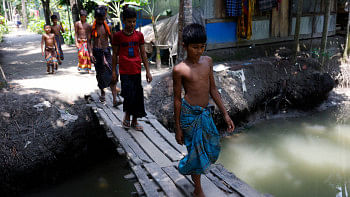Climate crisis and Bangladesh's toxic tangle with arsenic

In the heart of South Asia, Bangladesh faces a silent yet formidable foe: arsenic-contaminated water, a legacy of well-intentioned interventions now turned into a public health nightmare. The climate crisis, an unwelcome accelerant, is poised to push tens of millions of people towards the precipice of cancer risks, as recent studies suggest.
The origins of this crisis trace back to the 1970s when deep tube wells were drilled to combat infant mortality from waterborne diseases. These wells, tapping into the sedimentary gifts of the Himalayas, inadvertently unleashed arsenic into the water supply. By the 1990s, the grim reality surfaced: the water was laced with poison.
Dr Seth Frisbie, an emeritus professor of chemistry, paints a harrowing picture of villages devoid of elders, where arsenic's grip has left no one over the age of 30. The World Health Organization (WHO) has labelled this the "largest mass poisoning of a population in history," with the first case of chronic arsenic poisoning from drinking well water diagnosed in Bangladesh in 1993.
Fast forward to today, and the climate crisis is turning the screw on this already dire situation. Rising sea levels and increased flooding are altering the aquifer's chemistry, enhancing the release of arsenic through processes known as "reduction" and "the salt effect." These changes are not confined to Bangladesh but are echoed globally, from Manchester to Louisiana, underscoring the universal nature of this chemical menace.
The numbers are staggering: nearly half of the wells in Bangladesh exceed the WHO limit for arsenic concentration, with some areas reporting levels that are five times higher. Dr Frisbie's fieldwork revealed wells with concentrations as high as 448 parts per billion, far beyond the maximum permissible limit. The human cost is equally alarming, with an estimated 78 million Bangladeshis exposed to this toxic element and around 900,000 expected to succumb to lung and bladder cancer.
But the climate crisis is not content with merely exacerbating existing woes. It brings its own suite of challenges: salinity intrusion from rising sea levels, which further increases arsenic leaching into the water supply. This "salt effect" is a ticking time bomb for public health, set to increase the rates of death and disease from chronic arsenic poisoning.
The plight of Bangladesh is a microcosm of a global problem. The climate crisis knows no borders, and its effects ripple through the fabric of societies, economies, and ecosystems. As the world grapples with the enormity of climate change, Bangladesh stands on the frontlines, battling the dual threats of environmental degradation and public health emergencies.
Urgent action is needed. The country has made strides in adaptation and disaster risk management, reducing cyclone-related deaths significantly over the past 50 years. However, with climate risks escalating, further adaptation efforts are vital. Investments in infrastructure and services to strengthen climate resilience are imperative, as are actions focused on improved agriculture productivity, energy, and transport efficiency.
The World Bank underscores the urgency of climate action for Bangladesh to sustain strong growth. Without it, the country's progress could be jeopardised, and the human toll could be catastrophic. By 2050, a third of agricultural GDP could be lost, and 13 million people could become internal climate migrants. In the event of severe flooding, GDP could fall by as much as 9 percent.
So, the climate crisis is not just an environmental issue; it is a matter of life and death. For Bangladesh, the stakes could not be higher. The nation's resilience and response to this crisis will not only shape its future but also serve as a lesson for the world. As the waters rise, so too must our collective resolve to address the intertwined fates of climate and health.
Pranto Chatterjee is a former Indian Council for Cultural Relations (ICCR) scholar, holding a B.Tech in Electrical Engineering from NIT Durgapur, India.
Views expressed in this article are the author's own.
Follow The Daily Star Opinion on Facebook for the latest opinions, commentaries and analyses by experts and professionals. To contribute your article or letter to The Daily Star Opinion, see our guidelines for submission.

 For all latest news, follow The Daily Star's Google News channel.
For all latest news, follow The Daily Star's Google News channel. 










Comments